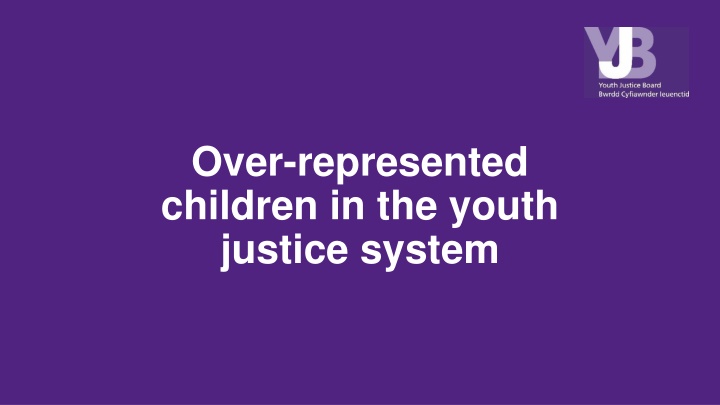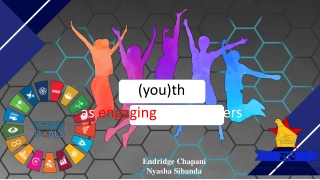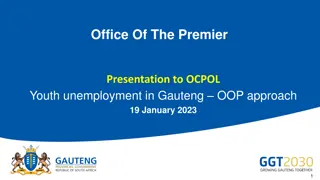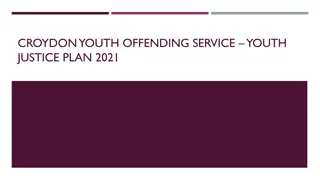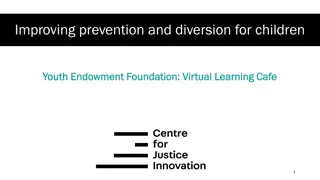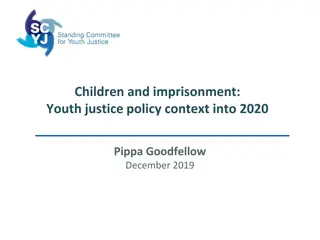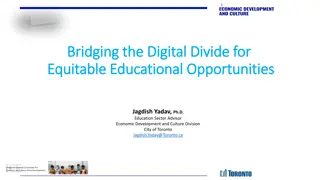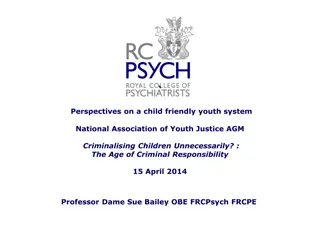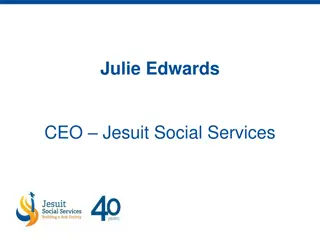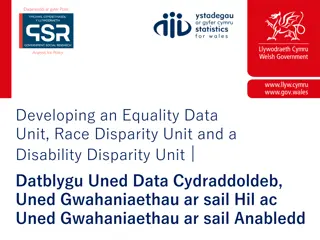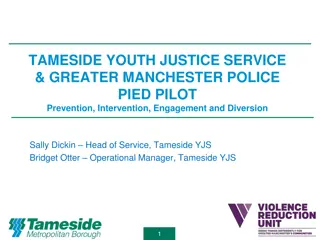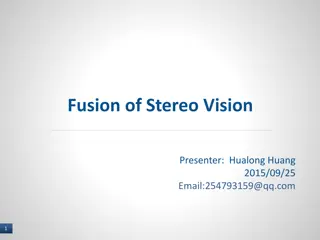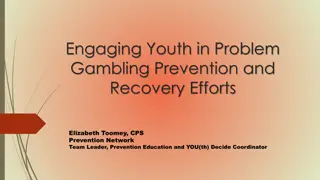Over-represented Children in Youth Justice System: Addressing Disparity
This content delves into the over-representation of children in the youth justice system, exploring racial disparity and the strategic initiatives taken to tackle this issue. Updates on data analysis, recent events affecting racial inequality, and cross-government collaborations are highlighted. The focus is on understanding how race impacts children within the justice system, with a call to observe, contribute, and work towards a fairer system.
Download Presentation

Please find below an Image/Link to download the presentation.
The content on the website is provided AS IS for your information and personal use only. It may not be sold, licensed, or shared on other websites without obtaining consent from the author.If you encounter any issues during the download, it is possible that the publisher has removed the file from their server.
You are allowed to download the files provided on this website for personal or commercial use, subject to the condition that they are used lawfully. All files are the property of their respective owners.
The content on the website is provided AS IS for your information and personal use only. It may not be sold, licensed, or shared on other websites without obtaining consent from the author.
E N D
Presentation Transcript
Over-represented children in the youth justice system
Welcome Keith Fraser, YJB Board Chair (session chair)
Update on the latest data: the national picture Adam Mooney, YJB Programme Manager, Over-represented children
Strategic direction and context Black Lives Matter and death of George Floyd recent UK events of Police abuse Race and Ethnic Disparity Commission chaired by Tony Sewell (Keith Fraser on board) Keir Starmer MP highlighting and challenging the PM on over-representation David Lammy Shadow Secretary of State for Justice challenge on progress since his review in 2017! Justice Select Committee interest in disproportionality Over-representation is one of the campaigns the YJB will highlight Cross Governmental Groups RAEB (Chaired by Director General James Bowler), Working Group, the Youth Justice System Oversight Group (YJSOG) Strategic Objective Meeting anyone is welcome to observe and contribute
Exploring racial disparity How it affects children in their early years and within the youth justice system August 2020 https://prezi.com/view/TEmgQ5ThTJLNTAFKULeC/ - using Prezi (for best results use a modern browser like Google Chrome or Microsoft Edge)
Association of Police and Crime Commissioners (APCC) Integrated Local Ethnic Disproportionality Tool - YJAF National Police Chief Council (NPCC) Over-Represented Children National Standards Pathfinders Levelling the Playing Field Employment Research
The Disproportionality Project: Addressing issues relating to the disproportionately high representation of Islington and Haringey s Black, Asian and Minority Ethnic children in the Criminal Justice System Curtis Ashton, Acting Director of Youth and Community, Islington Youth Offending Service An Evaluation Report by the Centre for City Criminology, City, University of London
Offenders in cohort # Reoffenders 500 70.0% Most deprived London borough (IDACI 2019) 58.6%57.3% 100 Lower gravity scores 54.6% 54.6% 60.0% 50.4% 47.6%49.3% 7 1 400 46.8% 80 10 - 66% 50.0% 11 10 60 300 40.0% 49 48 3 42 33 40 30.0% 200 391 27 Reduction in offending and re-offending 310 20 20.0% 284 284 28 244 26 26 24 220 100 17 197 189 155 155 10.0% 145 143 0 134 126 90 66 Q2 18-19 Q3 18-19 Q4 18-19 Q1 19-20 Q2 19-20 Low 0 0.0% Medium Youth Safety in Islington Islington 547 Q1 30 492 26 Q2 YOT Family 5 Q3 17 7 376 7 355 3 Q4 1 8 4 8 FY 2 12 10 22 6 4 1 Fewer First time entrants 2. 9 2016-17 2017-18 2018-19 2019-20 2.28 13 100 Less use of custody Lower gravity scores 10 1.50 7 1 80 7 1.34 10 11 5 10 60 49 0.66 48 3 42 33 40 27 20 Q2 2018- 19 Q3 2018- 19 Q4 2018- 19 Q1 2019- 20 Q2 2019- 20 28 26 26 24 17 0 Oct 15 - Sep 16 Oct 16 - Sep 17 Oct 17 - Sep 18 Oct 18 - Sep 19 Q2 18-19 Q3 18-19 Q4 18-19 Q1 19-20 Q2 19-20 Low Medium
About the children we work with 88% Male 60 Rate of outcomes Pre Court First Tier 50.2 50 42.4 37.4 40 Children in need 2/3 are open to Social Care 29.4 30 26.4 Children looked after 22.6 Youth offending service 18.4 18.1 20 13.6 12.4 10.8 9.0 Child Protection Plans 8.6 8.0 7.2 10 6.0 5.2 4.8 4.7 4.6 4.5 2.9 1.4 0.0 0 White Mixed Asian Black Other BAME Proportion of cautions and convictions given to children, by outcome type and ethnicity White BAME Not Known Total Custody Community First Tier Pre Court 9% 10% 11% 13% 14% 15% EET Offence Gravity Score by sentence outcome Missing Low Medium High Very High Community Custody Community Custody Community Custody Community Custody - - - 129 5 184 8 255 45 415 102 41 19 62 31 4 5 4 9 White Mixed Asian Black 23% 18% 32% 29% 26% - - 3 1 - - - - - - - - - 23% 82% school-age 43% Post-16 316 671 103 13 147 50 14 57% 52% 54% 68% 54% 54% 8 Other Not Known BAME TOTAL Average gravity scores (All cases) Average gravity scores (Custody cases only) 3.2 4.1 3.3 4.3 3.2 3.3 3.2 3.9 3.1 5.0 2.3 n/a 3.3 4.0 3.3 n/a 10% 10% EET NEET 7% 6% 5% 0% Other White Mixed Asian Black BAME
Background and Context Background and Context Second partnership project involving Islington Borough Council and criminologists at City, University of London. First project, Enhancing the work of the Islington Integrated Gangs Team, published in 2019. Third project is being worked on exploring the Andover estate and offending The project was designed to explore and tackle key issues and outcomes relating to disproportionate representation of Black, Asian and minority ethnic (BAME) young people in the Criminal Justice System and beyond. Programme attended by multiple agencies from two London Boroughs Islington and Haringey sought to strengthen multi-agency approach to addressing disproportionality. Islington Youth Services, Youth Offending Services and the Integrated Gangs Team. Haringey Youth Justice Service, Early Help and Youth Service. Police, Probation, education and health officers also attended sessions.
Disproportionality Programme Disproportionality Programme Four service aims: 1. To provide training around Adverse Childhood Experiences within BAME communities for staff 2. Setting up an initiative whereby parents from BAME backgrounds have a safe space to discuss the pressures associated with their children s involvement in ASB and/or offending behaviour and the structural and societal pressures they face. 3. Better support young people and their families from the poor outcomes and lack of opportunity which unfortunately, is more prevalent in BAME individuals and families eg in education, employment, income, health outcomes and treatment etc. The criminal justice system and Covid 19 are also examples of this 4. Strengthening communities who have been marginalized- helping to influence Islington and Haringey to shape and improve the services provided, so that young people and their families are supported to (improve outcomes and opportunities so they can) live their best life .
Evaluation Approach Evaluation Approach Research team attended all practitioner workshops, Aug-Nov. 2019. Interviews with cross-section of the frontline practitioners who attended workshops conducted at YOS sites in Islington and Haringey, respectively, in late 2019. Parents workshops, at neutral venues, recorded to evaluate project and identify parents lived experiences with regard to disproportionality. Young people engaged in CJS interviewed at YOS sites to capture experiences of criminal offending, victimisation, discrimination, racism , disproportionality. Evaluated delivery, outputs and, where possible, outcomes of Disproportionality Project.
Recommendations Recommendations
Traveller Young People and Disproportionality within Blackburn with Darwen Youth Justice Service Glenda Astley, Area Team Manager, Blackburn with Darwen Youth Justice Service
Disproportionality As at 7 February 2019 the traveller young person population within the youth justice system cohort was 7.94%. In the 2011 census, the 10-17 age group for this ethnicity only made up 0.18% of the population of young people in Blackburn with Darwen. This was a 44 times over-representation in the youth justice system cohort.
Case Studies Four case studies were scrutinised to discover some recurring themes. In particular and of concern at that time was the ratio of cases: referrals to the National Referral Mechanism (NRM), which was high.
Recurring themes Nature of Offences Element of dishonesty Use of counterfeit money prevalent Blackburn based young people appear nationwide, England, Scotland and Wales Violent offences serious with significant consequences Robbery serious acquisitive offences Driving - some young people drove illegally
Recurring themes Links to Child Criminal Exploitation (CCE) With emphasis on the counterfeit money there is a level of sophistication involved i.e. production of the notes, travelling around the country and the process of getting the notes into circulation. The process was too sophisticated for our young people to be masterminding and it was suspected that adults in the background were coordinating this. Referrals to Children s Social Care (CSC) made but rarely result in any significant intervention as families are reluctant to share. NRM referrals made for 60% of Cases.
Recurring themes Disproportionality/contrasting sanctions Recent experiences of young people arrested and charged with the same offences of Tendering Counterfeit Money and being processed in different ways. January 2019 Community Resolution March 2019 Crown Court sentence, all options PSR and sentenced to Youth Rehabilitation Order with 6 months Supervision Requirement and 30 day Activity Requirement.
Recurring themes The issue of child criminal exploitation is not being recognised in all cases resulting in the criminalisation of some young people.
Recurring themes Absent Fathers/ Family Criminality Majority originate from families where criminality is apparent currently and previously. The influence of this and possibly providing a link to CCE must be significant in shaping attitudes and behaviours of these young people in drawing them into criminality themselves. Role of fathers is often seen as absent, either they are literally absent or they play no active role. In one recent case one young traveller was arrested with his father, alongside other family members. The father s role in the crime led to him being remanded in custody.
Recurring themes Home Educated None of the Irish travellers we have worked with have been engaged in education, training or legitimate employment. Option of home education is readily adopted although very little education if any, appears to take place. Impact and consequences of this collectively and individually is that the young people have a significant amount of free time, they are not actively invested in improving their prospects and this fact alongside negative influences draw them into criminality.
Recurring themes Non engagement with CSC Distrust of Social Workers and any intervention is usually met with resistance and avoidance. Concerns of CCE, criminality in the home and non attendance at education would normally trigger some CSC input. Perception this is a cultural issue . Non engagement with family results in case closure.
Recurring themes Good engagement with YJS Majority want to be compliant and family members usually mums are behind the scenes supporting with this. Majority are cooperative, punctual and achieve a level of trust with their YJS Officer, a critical point in these cases to achieve effective supervision and intervention to occur. However, those that fall foul of this, commit more offences / are wanted by the police / Court, leave the area to avoid arrest and this becomes problematic in terms of ensuring they are safe.
Next steps for BeW YJS We presented our information to the NW Practice Development meeting in April 2019. We looked to develop our own response to the local need. Work was based on developing relationships Good Lives Model and Calverley (2013) Cultures of desistance.
What this looked like Question What are your experiences of life as a traveller ? Normalise their life for them support engagement. Relationship work Group work 360 supervision. Pilot for 3 months evaluate with young people and staff.
How our local Board helped? Police investigations to cover National PNC check Be mindful of potential CCE Education of workforce around NRM referrals Use links with YJS officers to broker relationships with young people and their families Challenge lack of meaningful education, training and employment
Todays picture Disproportionality reduced in Blackburn with Darwen to 3% from 7.94% over the last year A reduction in over 60% Sadly one young person is now incarcerated
